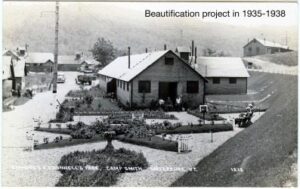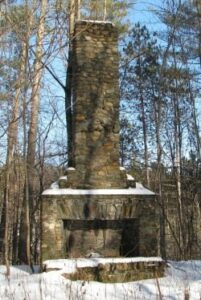Civilian Conservation Corps Camp #11064
CAMP CHARLES M. SMITH – WATERBURY, VT
Built September 1935-1939
Submitted by Anne Imhoff, Waterbury resident and volunteer historian.

At the height of the Great Depression that started in 1929 Franklin D. Roosevelt was elected President in 1933. About 14 million American workers were unemployed: 25% white adult males and 50% African American adult males.
Though Roosevelt would never win an election in Republican Vermont, his New Deal programs were welcomed during those hard times. One was the creation of the Civilian Conservation Corp Roosevelt signed into law on March 31, 1933.
The greatest concentration of CCC personnel on the east coast was in the 6th Civilian Conservation Corps District of the First Corps Area, in the Winooski River Valley, Vermont. It covered an area of 20 miles from Waterbury to East Barre and five miles from Montpelier to Wrightsville. Headquartered in Montpelier, it consisted of 26 white and three black companies, including Spanish-American war and World War I veterans. Together with officers, enlisted personnel and supervisors there were more than 5,300 persons occupying four large camps; the largest was in Waterbury, with close to 3,000 men.
The Great Flood of November 3-4, 1927 devastated Vermont and caused an estimated $21 million in damage. Vermont’s roads, bridges, and railways were hard hit, similar to the destruction caused by Tropical Storm Irene in August 2011.
The 1927 fall was a very wet one. When torrential rains began on November 3rd, the ground in the hills, from Waterbury to Stowe, was saturated and could not absorb additional water. In a 36-hour period, nine inches of rain fell and horrendous flooding began. Waters draining from mountain brooks and streams overflowed, turning the Little River that fed the Winooski River into a torrent. In Waterbury, the swollen Little River stopped the flow of the Winooski River, causing it to back up to a depth of over 15 feet in the village of Waterbury.
The state of Vermont purchased 10,000 acres from the Green Mountain Power Co. and other properties in the Little River Valley for the Waterbury dam. The road through the valley was thrown up and all but one of the houses in the small settlements was razed. Building Camp Charles M. Smith began in April 1935.
On June 1, 1935, the CCC Little River Dam Project started. The dam’s purpose is to hold back the waters of the Little River that drains the mountains on both sides of the Waterbury/Stowe valley, should another large flood occur.
The Waterbury dam is among the largest earth filled dams in New England. It is over 2,000 feet long with a width of 900 feet and a maximum height of 175 feet. The center portion of the dam comprises 500,000 cubic yards of earth. CCC enrollees placed heavy rocks by hand on the faces of the dam. It has a designed flood control capacity of approximately nine billion gallons and is 9th largest body of water in Vermont. Beneath the waters are the foundations of farmhouses, schools and churches that once formed the Little River and Cotton Brook communities.
Camp Smith consisted of 26 “U” shaped barracks, including one for the ‘black regiment’, housing about 100 men each with a mess hall for every four barracks. There was a library, school, theater, church, ice skating rink, administrative offices, hospital, engineering buildings, police station, farm, gas station, and a truck depot. There were day rooms, a recreation center and canteen buildings. The entire camp stretched over a mile in length on two plateaus.
Men signed up for six months and could “re-up.” They were paid $30 a month, $25 of which was sent home to their families. The average ages were 17-23 years, with a few men in their forties or older. The camp provided food, shelter and clothing. Work, calisthenics, marching drill, good food, and medical care were features of the CCC program.

Today, the Camp Smith buildings are gone but parts may still be seen, including the three stone fireplaces and chimneys, once part of the administration buildings. There are several cement platforms that may have been showers/bathrooms for the barracks. At the far end of the camp road, up a slight incline to the right and left of the road, on either side of a ravine, are the concrete and stone abutments for the 40-foot high mahogany dam that supplied water to the camp. Tucked in the hillside above the camp are concrete foundations for two 55,000 gallon mahogany water tanks that gravity feed water to the camp below.
To reach the CCC campsite take Rt. 2 East, from the Waterbury roundabout, 1.3 miles to Little River Rd. on the left. On Little River Rd. drive 2.4 miles to the top of the first short hill on the road, to an oval parking lot. The camp trails begin on the left.
